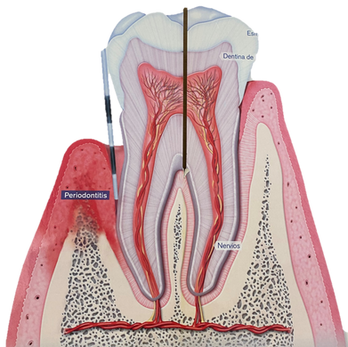
WHAT ARE THE
CAUSES?
Periodontal disease is a chronic condition that progressively destroys the bone supporting the teeth, eventually leading to tooth loss.
The accumulation of bacterial plaque due to poor oral hygiene causes inflammation of the gums (gingivitis), which can advance and affect the bone that supports the teeth (periodontitis).
As a result of the loss of bone tissue, so-called periodontal pockets develop, compromising the stability of the tooth and, over time, potentially leading to its loss.
Around 70% of tooth loss is caused by periodontitis, which highlights the importance of early diagnosis and treatment.

CONSEQUENCES:

-
Bleeding gums: Inflammation causes redness and pain in the gums — the first warning sign that something is wrong.
-
Bone loss: Teeth begin to lose the supporting gum between them, making them appear longer.
-
Improper chewing: Inadequate chewing can lead to digestive problems due to insufficient breakdown of food.
-
Speech changes: Teeth are essential for pronouncing certain sounds, which becomes difficult when teeth are missing.
-
Bad breath: Volatile sulphur compounds from periodontitis-related bacteria cause persistent bad breath.
-
Aesthetics: Individuals with missing teeth often feel self-conscious about their appearance.
-
General health: An infected mouth can directly impact overall health, contributing to conditions such as diabetes, cardiovascular disease, premature birth, rheumatoid arthritis, and obesity, among others.
DIAGNOSIS:
1
-
Clinical examination:
We carry out a periodontal chart (periodontogram), which includes six depth measurements around each tooth, along with assessments of bleeding, mobility, and other clinical signs.
2
Radiographic examination:
A full set of periapical X-rays is taken to accurately assess the bone surrounding each tooth.
3
Microbiological analysis:
In specific cases, we analyse the bacteria present in the patient’s mouth to target and eliminate harmful microorganisms.


The periodontal radiographic series consists of 18–20 small detailed X-rays.
The periodontogram includes six measurements around each tooth.
TREATMENT
The main objective of treatment is to reduce gum inflammation by decontaminating the periodontal pockets of excessive bacteria that attack the gums and lead to bone loss.
This decontamination process is known as scaling and root planing, commonly referred to as deep cleaning. It is performed using air polishers, ultrasonic devices, and periodontal curettes. In some cases, we find that the root surfaces are very rough, which encourages tartar accumulation — in such situations, we also smooth the root surfaces.
If any teeth are mobile, we will assess whether an occlusal adjustment is necessary — essentially, rebalancing the bite to improve chewing function and reduce stress on affected teeth.

PERIODONTAL RE-EVALUATION:

Between 4 and 8 weeks after gum decontamination, we carry out a new periodontal charting (periodontogram), just as we did during the initial examination, to assess the outcomes of the treatment.
This allows us to evaluate several key parameters essential for treatment success:
-
Review the patient’s oral hygiene techniques and address any questions or concerns.
-
Assess the condition of the gums — reduction of inflammation, closure of periodontal pockets, and overall healing progress.
-
Identify areas that have not responded well to treatment, in order to apply additional or targeted therapy where necessary.
-
Establish the appropriate frequency for periodontal maintenance tailored to the patient’s individual needs.
PREVENTION OF PERIODONTITIS

Prevention is key to avoiding the development of chronic conditions such as periodontitis (gum disease).
At our dental clinic in the centre of Málaga, we dedicate significant time and effort to raising awareness among our patients about the importance of adopting healthy habits to prevent the onset and progression of periodontitis. We place special emphasis on:
-
Proper oral hygiene techniques to effectively remove bacterial plaque.
-
Avoiding tobacco use, which is directly linked to periodontal disease.
-
Maintaining a healthy diet by reducing foods high in fat and carbohydrates, which helps control overall inflammation in the body.
-
Attending regular check-ups at our clinic.
-
Routine cleanings to prevent the build-up of tartar and plaque.
Cases Treated by Dr. Ramón Ceballos
CASE 1: BEFORE
CASE 1
Mouth with severe inflammation and tartar build-up, diagnosed as chronic periodontitis.

CASE 2: BEFORE
Patient with acute gum disease due to severe tartar accumulation.

CASE 1: AFTER
Case 1
After periodontitis treatment, the gum is no longer inflamed and does not bleed.

CASE 2: AFTER
Healthy gums after treatment with Dr. Ramón Ceballos

There are 3 main stages of gum condition:
-
Healthy gums: Gums are pink and do not bleed when brushing or using dental floss. The depth of the sulcus (the space between the tooth and the gum) is 1–3 mm.
-
Gingivitis: A reversible inflammation of the gums, which bleed during brushing. The sulcus depth ranges from 1–4 mm. If left untreated, it can progress to periodontitis.
-
Periodontitis: A chronic and irreversible disease characterised by bone loss. The depth of the periodontal pockets can reach up to 10 mm. It is the leading cause of tooth loss and can also negatively affect overall health.




